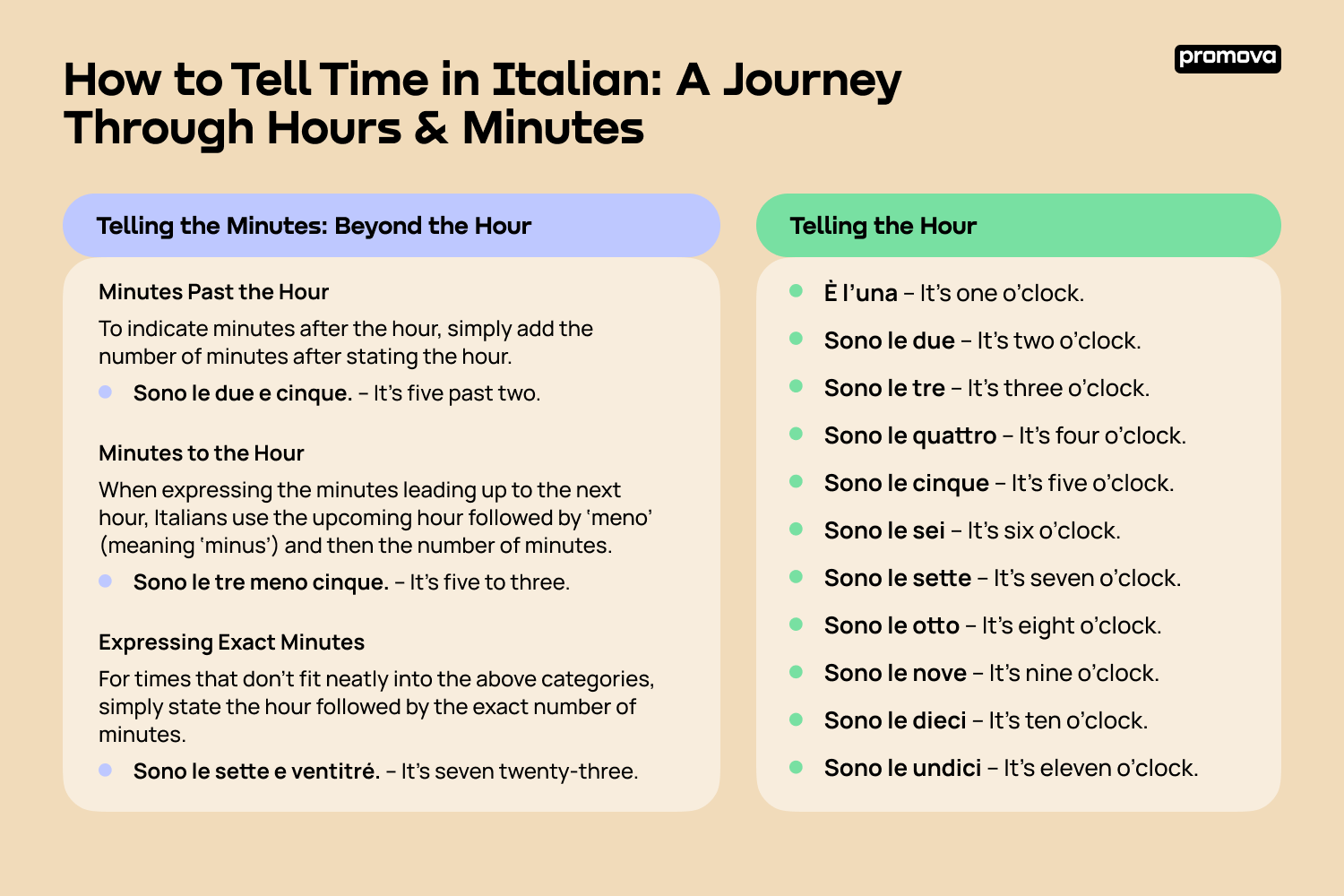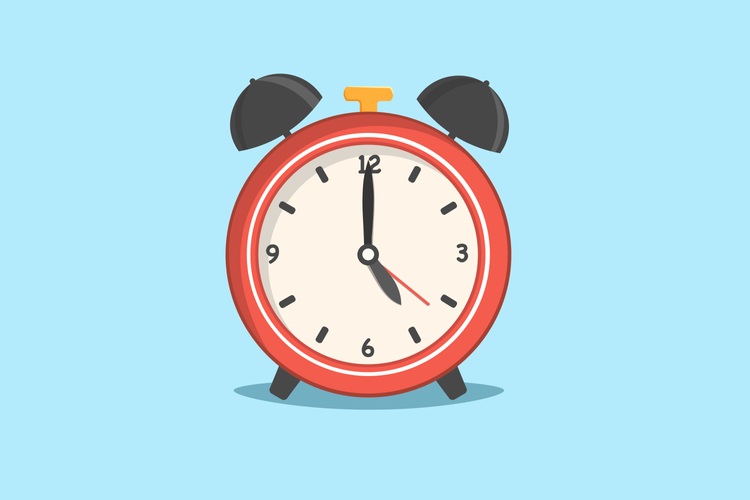How to Tell Time in Italian: A Journey Through Hours & Minutes

Contents
Telling time is fundamental in any language, but in Italian, it’s an art of its own. If you’re planning a journey to the heart of Italy or just fascinated by this beautiful language, mastering telling time in Italian can significantly improve your conversational skills. This guide will provide everything from phrases for asking the time to expressing it in formal and informal contexts.
The 12-Hour Clock vs. The 24-Hour Clock in Italian
In many cultures, the 12-hour clock is commonplace for everyday conversations. However, Italy has a distinct preference for the 24-hour clock, especially in specific contexts. This system, often called ‘military time’ in other countries, eliminates the need for ‘AM’ and ‘PM’ distinctions.
For casual conversations among friends or family, Italians might use the 12-hour format. For example, depending on the context, ‘Le sette’ could mean 7 AM or 7 PM. But when precision is essential, the 24-hour clock comes into play. Train schedules, TV programs, and official appointments usually follow this format.
It’s important to note that while the 24-hour clock is widely used, Italians often omit the hour’s final ‘zero.’ What a foreigner might represent as 20:00, an Italian might express simply as ‘Le venti,’ meaning ‘twenty.’
Asking What Time in Italian: Popular Phrases You Should Know
Knowing how to inquire about the time is essential when navigating daily life in Italy or conversing in Italian. The language offers various phrases, each suitable for different contexts. Here are some of the most popular ones:
- Che ore sono?
It is the standard way to ask, ‘What time is it?’ in Italian. Direct and to the point, it’s the go-to phrase for many, whether in a bustling city square or a quiet village.
Scusa, che ore sono? (Excuse me, what time is it?)
- Mi può dire l’ora, per favore?
A more formal way to inquire about the time, this phrase translates to ‘Can you tell me the time, please?.’ It’s particularly useful in formal settings or when addressing someone you don’t know well.
Signore, mi può dire l’ora, per favore? (Sir, can you tell me the time, please?)
- Sai che ore sono?
It is a casual and colloquial way to ask, ‘Do you know what time it is?.’ It’s often used among friends or in informal settings, making it a handy phrase for relaxed environments.
Ehi, sai che ore sono? (Hey, do you know what time it is?)
- Potresti dirmi l’ora?
This phrase translates to ‘Could you tell me the time?.’ It balances formality and informality, making it versatile for various situations.
Potresti dirmi l’ora, ti prego? (Could you tell me the time, please?)
Telling the Hour: Expressing Simple Time in Italian
When indicating a specific hour in Italian, the verb ‘essere’ in its forms ‘è’ and ‘sono’ is used. For one o’clock, the singular form ‘è’ is utilized. The plural form ‘sono’ is the go-to choice for all other times. Here’s a breakdown:
- È l’una – It’s one o’clock.
- Sono le due – It’s two o’clock.
- Sono le tre – It’s three o’clock.
- Sono le quattro – It’s four o’clock.
- Sono le cinque – It’s five o’clock.
- Sono le sei – It’s six o’clock.
- Sono le sette – It’s seven o’clock.
- Sono le otto – It’s eight o’clock.
- Sono le nove – It’s nine o’clock.
- Sono le dieci – It’s ten o’clock.
- Sono le undici – It’s eleven o’clock.
- Sono le dodici – It’s twelve o’clock.
It’s essential to note the use of ‘le’ from two o’clock onwards, indicating the plural hours. This distinction is crucial if you want to tell time in Italian correctly, making your grammar more authentic and precise.
Using ‘Quarto’ and ‘Mezza’: Quarter and Half Hours
In Italian, just like in many languages, specific terms denote quarter and half hours. These terms not only simplify time-telling but also add a touch of cultural authenticity to your conversations. Let’s delve into how ‘quarto’ and ‘mezza’ express time.
- ‘Quarto’: The Quarter Hour
The term ‘quarto’ translates to ‘quarter’ in English. When telling time, it indicates a quarter past or a quarter to the hour.
È l’una e un quarto. – It’s a quarter past one.
Sono le due meno un quarto. – It’s a quarter to two.
- ‘Mezza’ or ‘Mezzo’: The Half Hour
‘Mezza’ (feminine) or ‘mezzo’ (masculine) means ‘half.’ In the context of time, ‘mezza’ indicates half past the hour.
È l’una e mezza. – It’s half past one.
Sono le tre e mezza. – It’s half past three.
It’s worth noting that while ‘mezza’ and ‘quarto’ simplify time-telling, they also reflect the rhythmic flow of the Italian language. By incorporating these terms into your vocabulary, you’ll express time more efficiently and sound more fluently in your conversations.
Telling the Minutes: Beyond the Hour
While expressing the hour is foundational, diving into the minutes provides a more detailed and precise time-telling experience. In Italian, conveying minutes past or to the hour involves specific structures and terms. This section will guide you through the nuances of articulating minutes in Italian.
- Minutes Past the Hour
To indicate minutes after the hour, simply add the number of minutes after stating the hour.
Sono le due e cinque. – It’s five past two.
Sono le tre e dieci. – It’s ten past three.
- Minutes to the Hour
When expressing the minutes leading up to the next hour, Italians use the upcoming hour followed by ‘meno’ (meaning ‘minus’) and then the number of minutes.
Sono le tre meno cinque. – It’s five to three.
Sono le quattro meno dieci. – It’s ten to four.
- Expressing Exact Minutes
For times that don’t fit neatly into the above categories, simply state the hour followed by the exact number of minutes.
Sono le sette e ventitré. – It’s seven twenty-three.
Sono le otto e quarantanove. – It’s eight forty-nine.
Mastering the art of telling minutes enhances your linguistic precision and ensures you’re always punctual, whether catching a train in Rome or attending a meeting in Milan.

Periods of the Day: From Dawn to Dusk and Beyond
In Italian, different parts of the day have their distinct terms. They are essential for setting the context of events, making plans, or discussing daily routines. Let’s explore the Italian terms that denote various periods of the day:
- Mattina – Morning.
- Pomeriggio – Afternoon.
- Sera – Evening.
- Notte – Night.
- Mezzogiorno – Midday or Noon.
- Mezzanotte – Midnight.
- Alba – Dawn.
- Tramonto – Sunset.
- Giorno – Day.
- Madrugada – Early morning or the wee hours.
These terms provide a comprehensive overview of the day’s progression, helping you clearly pinpoint any moment and tell time in Italian. To specify the time with these periods, use ‘di’ before the period. For example, ‘di mattina’ would mean ‘in the morning,’ ‘di pomer iggio’ translates to ‘in the afternoon,’ and so on.
Basic Vocabulary: Foundation of Time-Telling
Now that we understand periods of the day and how to express hours, let’s familiarize ourselves with basic vocabulary fundamental to telling time. From the Italian word for time essential terminologies, these words and phrases often come up in time-related conversations:
- Ora – Hour.
- Minuto – Minute.
- Secondo – Second.
- Settimana – Week.
- Mese – Month.
- Anno – Year.
- Stagione – Season.
- Orologio – Clock or watch.
- Tardo – Late.
- Presto – Early.
- Durata – Duration.
- Tempo – Time.
- Adesso – Now.
- Dopo – After or later.
- Prima – Before or earlier.
These terms form the bedrock of time-related conversations in Italian. By mastering them, you’ll find it easier to navigate various contexts, from scheduling appointments to discussing past and future events.
7
Time in Italian Sayings
Italian culture is deeply intertwined with its language, which is evident in its many idiomatic expressions. Many of these sayings revolve around time, reflecting the nation’s values, history, and perspectives on life’s transient nature:
- Il tempo vola – Time flies.
- Meglio tardi che mai – Better late than never.
- Tempo al tempo – Time will tell.
- Dopo la pioggia viene il bel tempo – After the rain, good weather will come (Every cloud has a silver lining).
- Ogni cosa a suo tempo – Everything in its own time.
- Il tempo è denaro – Time is money.
- Nel tempo libero – In one’s free time.
- Tempo fa – Some time ago.
- Perdere tempo – To waste time.
- Tempo permettendo – Weather permitting.
- Uccidere il tempo – To kill time (To pass the time).
- Da tempo immemorabile – Since time immemorial.
- Il tempo cura tutto – Time heals everything.
- A tempo debito – In due time.
These sayings hold a lesson or a reflection on life’s various facets. They underscore the importance of time, the inevitability of change, and the need to value every moment. Familiarizing oneself with these expressions enhances linguistic prowess and deepens one’s understanding of Italian culture.
Cultural Nuances: Time Perception in Italy
Italy, with its rich history, traditions, and regional diversities, has a unique perspective on time. This relationship with time is not just about the clock’s ticking but is deeply rooted in the culture and lifestyle. Let’s explore some cultural nuances related to time perception in Italy:
- The Italian Siesta. While not as prolonged as the Spanish siesta, many Italians take a midday break known as ‘la pausa.’ Shops might close, and streets can be quieter as people retreat home for lunch and rest. This break, usually between 1 PM and 4 PM, shows the Italian emphasis on work-life balance.
- Punctuality. If you’ve arranged to meet an Italian friend and they’re a little late, don’t be surprised. There’s a relaxed approach to punctuality in casual settings, often called ‘l’ora italiana.’
- Sacred Meal Times. Meal times in Italy are almost sacred. Dinners can stretch for hours, especially during family gatherings or festivities. It’s less about watching the clock and more about savoring the moment, the food, and the company.
Understanding these cultural nuances offers a deeper appreciation of Italy and its people. It’s not just about telling the time; it’s about understanding the rhythm, pulse, and heartbeat of a nation.
Experience Effective Language Learning with Promova
Start your language learning journey with Promova, the one-stop solution for effective acquisition. Whether you want to improve your English, French, Spanish, Korean, German, or Italian skills, Promova has the resources and tools to help you reach your goals.
With Promova’s language learning platform, you can access guided courses that cater to students of all proficiency levels. These courses are available on the Promova app and website, providing a convenient learning experience wherever you are. In these courses, structured lessons cover vocabulary, grammar rules, and interactive quizzes to enhance language skills. You can learn at your own pace and tailor the process according to your preferences.
English learners can take advantage of personalized 1x1 lessons and group classes. These sessions offer a unique chance to practice speaking English with experts who provide immediate feedback. If you sign up, you’ll get a free personal lesson, giving you a taste of what our tutoring sessions offer.
But the learning experience doesn’t stop there. Promova goes beyond textbooks with a regularly updated blog. Here, you can explore various topics, ranging from grammar rules to idioms and cultural aspects of the language you’re learning. The blog provides additional insights and knowledge to enrich your language journey.
Conclusion
Knowing how to tell time in Italian goes beyond mere numbers and phrases; it’s a journey into the heart of Italian culture. From the rhythmic flow of daily life to the wisdom encapsulated in age-old sayings, time in Italy is both a measure and a metaphor. As you embrace these linguistic nuances, you’ll find yourself not just speaking but truly living the language, appreciating every moment with the depth and passion that is quintessentially Italian.
FAQ
Are there regional variations in Italy regarding time-related sayings or practices?
Yes, Italy’s diverse regions, each with its unique history and traditions, have local expressions and practices related to time. While standard Italian is understood everywhere, regional nuances can enrich conversations, especially with locals.
How do Italians perceive punctuality in business settings?
In business settings, Italians generally value punctuality. Being slightly early or on time is a sign of professionalism and respect. While there might be a relaxed approach to time in casual settings, business engagements usually adhere to a stricter time frame.
How to learn new Italian expressions related to time?
One of the best ways to learn new expressions is by immersing yourself in the language. Listen to Italian music, watch Italian films, read Italian books or newspapers, and try to converse with native speakers if possible.
What are some resources for learning Italian vocabulary?
For Italian, WordReference and Collins Italian-English Dictionary are excellent online resources. These platforms offer detailed explanations, translations, and examples of Italian time-related terms.



Comments